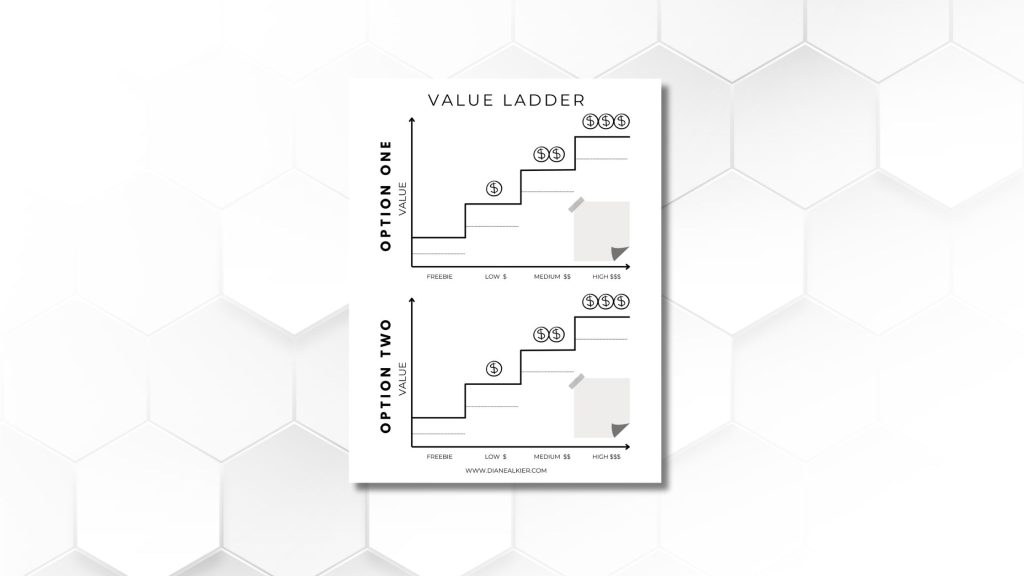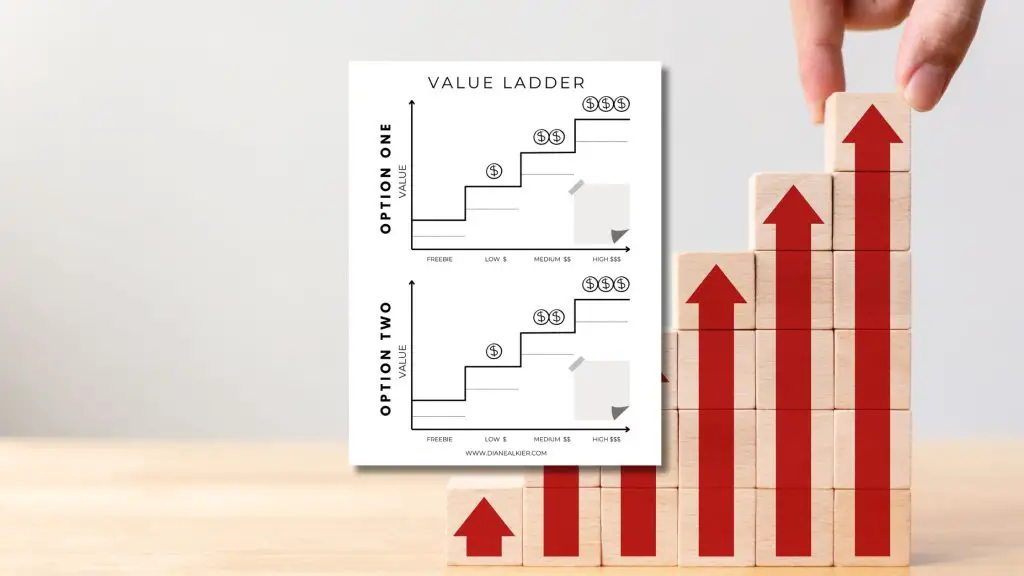In the world of digital marketing, understanding the value of your product and how to communicate it effectively to customers is key. One of the tools that can help you do this is a product value ladder. I first learned about this concept in the book Dotcom Secrets by Russell Brunson and applied it to my Etsy Shop. In this blog post, we’ll take a deep dive into what a product value ladder is, why it’s important for digital marketers, and explain the key parts of a value ladder. We’ll also provide examples of value ladders for digital products and provide you with your own Product Value Ladder Worksheet.
What is a Product Value Ladder?
A product value ladder, as defined in “Dotcom Secrets,” is a sequential arrangement of products or services that increase in value and price. It’s a strategic model that helps businesses lead their customers from low-cost or free offerings to higher-priced options. By offering an irresistible value at a low cost or even for free, businesses can establish trust and a real connection with customers. This type of product paves the way for them to be more inclined to grab those higher-priced products down the line!
Why is a Value Ladder Important for Digital Marketers?
For digital marketers, a value ladder is an essential tool for customer retention and revenue growth. It allows you to demonstrate the value you can provide to customers at different price points. Starting with low-cost or free offerings is an awesome way to attract a diverse range of potential customers. As customers progress up the ladder, they become more invested in your brand and are more likely to make larger purchases. This progress up the latter increases revenue and builds a loyal customer base.
The Parts of a Value Ladder
The traditional value ladder consists of four main parts: the Freebie, the Low-Priced Product, the Medium-Priced Product, and the High-Priced Product.
- Freebie: This is a product or service that you offer for free to attract potential customers. It could be a free trial, ebook, or even a free consultation. The goal is to provide value and build trust with your prospects.
- Low-Priced Product: This is a low-cost product designed to convert free users into paying customers. It should offer significant value for a small price. Examples include a basic software subscription or an introductory online course.
- Medium-Priced Product: This is a more comprehensive product that offers greater value than the low-priced product. It could be an advanced course or a premium software subscription.
- High-Priced Product: This is your most expensive offering. It could be a high-end consulting service, a comprehensive training program, or a high-level membership.
Explore More: Free Freebie Ideas List
Example of Value Ladders for Digital Products
To illustrate how a value ladder works, let’s take the example of an Etsy shop that specializes in digital products for small business branding:
- Freebie: A free downloadable guide on “How to Create a Memorable Brand for Your Small Business.” This guide provides potential customers with valuable information while introducing them to the shop’s expertise and style.
- Low-Priced Product: A collection of customizable social media templates. For a small fee, customers can elevate their online presence with professional-looking graphics.
- Medium-Priced Product: An all-in-one branding kit, including logo designs, business card templates, letterhead designs, and more. This medium priced product offers a more comprehensive solution for businesses looking to establish a cohesive brand identity.
- High-Priced Product: A fully custom branding package where the shop works directly with the customer to create a one-of-a-kind brand identity, including logo design, brand color palette, typography, custom social media templates, and more.
With the help of this value ladder, the Etsy shop captures the attention of customers with diverse price points and needs, skillfully leading them towards irresistible, higher-value purchases.
Here’s another example of a value ladder for an Etsy shop that sells digital planners:
- Freebie: A free downloadable “Ultimate Guide to Digital Planning .”This freebie will provide potential customers with valuable insight into the world of digital planning and showcase the shop’s expertise.
- Low-Priced Product: A basic digital daily planner. This affordable option allows customers to organize their day-to-day tasks efficiently.
- Medium-Priced Product: A comprehensive digital business planner. This planner includes sections for goal setting, project management, financial tracking, and more, offering a more robust tool for entrepreneurs or small business owners.
- High-Priced Product: A personalized digital planner service. With this premium service, customers can have a planner designed specifically for their needs and preferences, including custom sections, colors, and designs.
This type of value latter is how the Etsy shop can draw in diverse customers, catering to their unique needs and budgets while gently nudging them towards splurging on higher-value purchases.
Explore More: Brainstorming Product Ideas Worksheet
Product Value Ladder Worksheet

A product value ladder is a game-changer for digital marketers and entrepreneurs. Mastering and skillfully implementing this concept has the power to allure a greater customer base, amplify revenue, and cultivate a devoted community. This strategic approach allows you to offer various products/services that meet different customer needs, fostering long-term relationships and delivering maximum value to your target audience. I hope this free Product Value Ladder Worksheet helps you elevate your digital product business to new heights!
